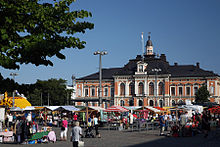Kuopio
![]()
This article is about the Finnish city of Kuopio; for other meanings, see Kuopio (disambiguation).
Kuopio [![]()
![]() [ˈkuɔ̯piɔ]] is a city in the Savo region of Finland. With 120,210 inhabitants (as of 31 December 2020), it is the ninth largest city in the country and the largest city in Eastern Finland. Kuopio is the administrative seat of the North Savo County, a university town, the seat of an Orthodox archbishop as well as a Lutheran bishop, a winter sports resort and a popular holiday destination. The centre of Kuopio is located on a peninsula on Lake Kallavesi, the urban area of Kuopio is 3700 square kilometres in total.
[ˈkuɔ̯piɔ]] is a city in the Savo region of Finland. With 120,210 inhabitants (as of 31 December 2020), it is the ninth largest city in the country and the largest city in Eastern Finland. Kuopio is the administrative seat of the North Savo County, a university town, the seat of an Orthodox archbishop as well as a Lutheran bishop, a winter sports resort and a popular holiday destination. The centre of Kuopio is located on a peninsula on Lake Kallavesi, the urban area of Kuopio is 3700 square kilometres in total.
Geography
Kuopio is located 390 kilometres north of Helsinki in the centre of the eastern Finnish landscape of North Savo. Kuopio's neighbouring towns and municipalities are Siilinjärvi and Lapinlahti to the north, Rautavaara to the northeast, Kaavi and Tuusniemi to the east, Leppävirta to the south, Suonenjoki to the southwest, Tervo to the west and Maaninka to the northwest. Kuopio has merged with the closely connected surrounding municipalities of Karttula, Maaninka and Siilinjärvi to form the Kuopio Administrative Community.
The core city of Kuopio lies on a peninsula in Lake Kallavesi in the shadow of the 232-metre-high Puijo hill. The lake is 82 metres above sea level. However, the city proper, with an area of 45 square kilometres, occupies only a fraction of Kuopio's administrative urban area. The latter, after a series of incorporations, covers an area of 3740 square kilometres. Much of the area is rural in structure. More than a quarter of the area consists of inland waters. The largest lake by far is Kallavesi, the tenth largest lake in Finland at 478 square kilometres.
Localities
In addition to the core city, Kuopio includes other settlement centers (taajama): (population figures as of 31 December 2011):
- Core city (82,268 inhabitants)
- Nilsiä (3.174 Inhabitants)
- Karttula (925 Inhabitants)
- Melalahti (797 Inhabitants)
- Kurkimäki (682 Inhabitants)
- Vehmersalmi (608 Inhabitants)
- Pellesmäki-Vehmasmäki (508 Inhabitants)
- Pihkainmäki (450 Inhabitants)
- Hiltuanlahti (242 Inhabitants)
- Syvänniemi (240 Inhabitants)
- Toivala-Vuorela (146 Inhabitants)
With the incorporation of Maaninka, the villages of Haatala, Halola, Hamula, Jynkänniemi, Kinnulanlahti, Kurolanlahti, Käärmelahti, Leinolanlahti, Lappetelä, Pohjois-Haatala, Tavinsalmi, Tuovilanlahti, Varpasmaa, Venäjänsaari, Vianta and Väänälä were added.
Climate
| Kuopio | ||||||||||||||||||||||||||||||||||||||||||||||||
| Climate diagram | ||||||||||||||||||||||||||||||||||||||||||||||||
| ||||||||||||||||||||||||||||||||||||||||||||||||
| Monthly average temperatures and precipitation for Kuopio
Source: WMO | ||||||||||||||||||||||||||||||||||||||||||||||||||||||||||||||||||||||||||||||||||||||||||||||||||||||||||||||||||||||||||||||||||||||||||||||||||||||||||||||||||||||||||||||||||||||||||||||||

View of Kuopio from Puijo Tower
History
Kuopio was first mentioned in a document in 1552, when a church was built and a parish established on the Kuopionniemi peninsula, now the Väinölänniemi district, at the instigation of Mikael Agricola and others. In 1653 Kuopio was elevated to the status of a city by the Swedish governor Per Brahe, but already in 1681 the city rights were withdrawn again. By decree of King Gustav III of Sweden, Kuopio was refounded on November 17, 1775, and became the capital of the newly created province of Savo-Karelia.
In 1809 Kuopio, along with the rest of present-day Finland, became part of Russia and the newly formed Grand Duchy of Finland. The provincial reform in 1831 replaced the province of Savo-Karelia with the province of Kuopio. With the construction of the Taipale Canal in 1840, the Konnus Canal in 1841 and the Saimaa Canal in 1856, it was now possible to reach the Baltic Sea from Kuopio. This development of the waterway accelerated the growth of the city in the second half of the 19th century, so that Kuopio developed into an important inland port and trade centre. On October 1, 1889, the railway reached the city from Kouvola.
With the Finnish Declaration of Independence in 1917, Savonlinna also became part of the independent Republic of Finland. In 1939 Kuopio became the seat of the Evangelical Lutheran Diocese of Kuopio. During the Winter War and the Continuation War, several Soviet air raids were carried out on the city, which caused a total of 38 civilian deaths, and 0.5% of the housing was destroyed and 1.1% severely damaged.
After the SecondWorld War, the city grew due to the settlement of refugees from Karelia, which was ceded to the Soviet Union. In 1972, Kuopio University was founded, which merged with Joensuu University in 2010 to form the University of Eastern Finland. As a result of the 1997 provincial reform, Kuopio lost its status as provincial capital: the former province of Kuopio now became part of the province of Eastern Finland, with Mikkeli as its capital.
Originally, the city of Kuopio comprised only the urban area proper and was surrounded by the rural municipality of Kuopio. In the meantime, however, the administrative area of the city has expanded considerably as a result of a series of incorporations. In 1969, the rural municipality of Kuopio was dissolved and most of it was incorporated into the city of Kuopio. In 1973, Riistavesi was incorporated. Vehmersalmi was incorporated in 2005, Karttula in 2011 and Nilsiä in 2013. The most recent incorporation took place on 1 January 2015 with Maaninka.

The town hall on Kuopio's market square was built in 1882-1886.
Search within the encyclopedia